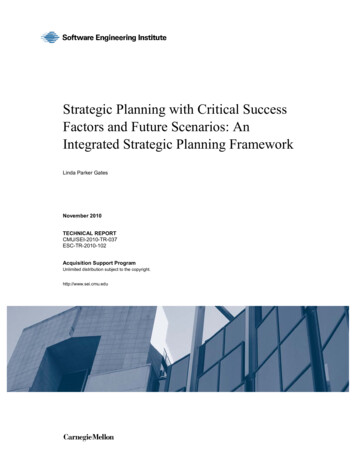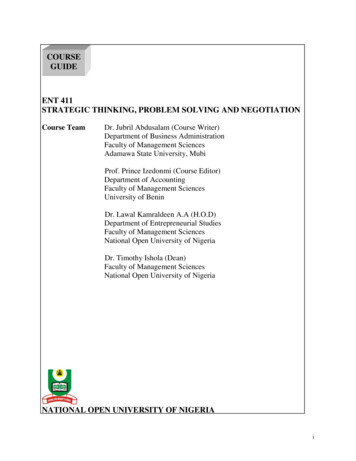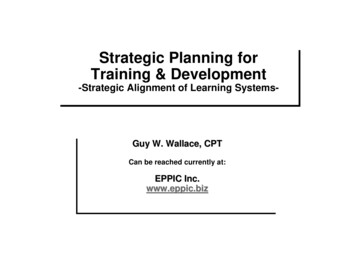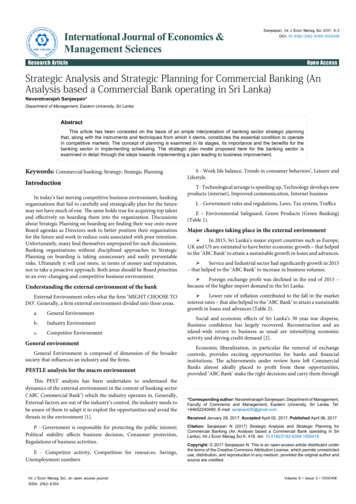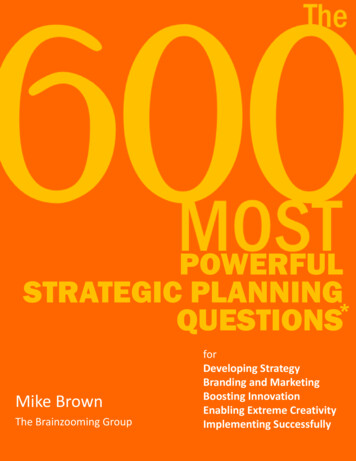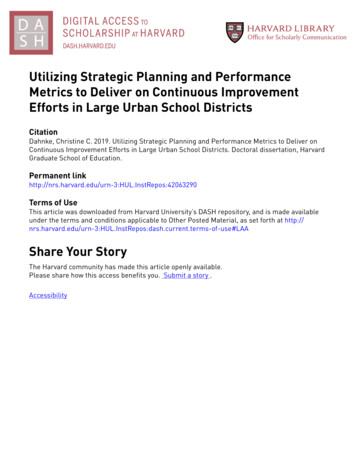
Transcription
Utilizing Strategic Planning and PerformanceMetrics to Deliver on Continuous ImprovementEfforts in Large Urban School DistrictsCitationDahnke, Christine C. 2019. Utilizing Strategic Planning and Performance Metrics to Deliver onContinuous Improvement Efforts in Large Urban School Districts. Doctoral dissertation, HarvardGraduate School of Education.Permanent 63290Terms of UseThis article was downloaded from Harvard University’s DASH repository, and is made availableunder the terms and conditions applicable to Other Posted Material, as set forth at rrent.terms-of-use#LAAShare Your StoryThe Harvard community has made this article openly available.Please share how this access benefits you. Submit a story .Accessibility
Utilizing Strategic Planning and Performance Metrics to Deliver onContinuous Improvement Efforts in Large Urban School DistrictsDoctor of Education Leadership (Ed.L.D.)CapstoneSubmitted byChristine C. DahnkeTo the Harvard Graduate School of Educationin partial fulfillment of the requirements for the degree ofDoctor of Education Leadership.April 2019
“I can fly higher than an eagle,for you are the wind beneath my wings.”-lyrics by Jeff Silbar and Larry HenleyI dedicate this capstone to my Mom, you are my hero,And to my husband Onnie, thank you for always letting me shine.1
AcknowledgementsTo my family. In the words of Theo, “Guess what? I love you.” I love you forsaying yes and for enjoying the adventures of life by my side. I love you for yourunconditional support and for giving more of yourself that humanly possible sothat I can live out this dream. Here’s to a lifetime of laughter and newexperiences to come.To DJS. Divine intervention may have connected us, but you’ve done the rest.Your powerful belief that I have “something inside so strong” helped me toblossom. Because of your mentorship I have had transformative growthexperiences and I can proudly say that you’ll never catch me “waiting on theworld to change”.To John Kim. Thank you for your feedback and guidance. I have sharpened mythinking, broadened my understanding and produced better outcomes becauseof your investment in me. Furthermore, I’ll never see air travel the same.To Dr. Bridget Williams. Your critical sponsorship paved the way for my success.Thank you for always being your authentic self and modeling servant leadership.As you frequently repeated, “when you become superintendent,” I began tobelieve this is my destiny. Thank you for lighting the path.To Dr. Jenkins and all of OCPS. Thank you for inviting me into your house, andtrusting me to tell this part of your story. I am fully implicated in this work andlook forward to our continuous improvement journey.To C7, the EdLD network, HGSE and the greater Harvard community. Thankyou for the learning and the memories. These past three years have exceededany expectations I might have arrived with to Appian Way and I look forward tothe collective impact our efforts will have far into the future.To my mentors: Mari-Carmen Caballero, Cece Magrath, Ester de Jong, SylviaJohnson, Otilia Salmón, Rhonda Bondie, Jennifer Sasser. You show me whatwomen empowerment is all about.To Nikolai Vitti for being my role model. Thank you for never wavering: “Wealways do what’s best for kids.” Your example is deep in my bones.To my ETO Team and my ESOL/DL/WL Family, from our shared experiences Ilearned how to be a leader. Thank you for your honesty and feedback.To my tribe from across zip codes. One cannot thrive without great friends. Jill,Renee, Ingrid, Hind, Dani, Wara, Marie-Claire, Mary, Kathi, Simone, Jess, Alison,Kelvin, Erin, Lyndsay and Javier, you always brighten my day and I thank you.2
TABLE OF CONTENTSAbstract4Introduction5Residency SiteStrategic ProjectReview of Knowledge for Action51113Strategic Planning and Management13Organizational Change23Theory of Action26Description, Evidence and Analysis of Strategic Project27Description of Strategic Project: The What and How27Analysis: The Why37Evidence to Date52Implications for Self56Implications for Site61Implications for Sector69Conclusion76Bibliography77Appendix813
AbstractIteration on the strategic planning process increases systemic coherence, guidescontinuous improvements and enhances distributed accountability, therebyleading to higher performance throughout an organization. The social covenant ofpublic school systems to provide high-quality educational opportunities for theirstudents, and the potential impact of comprehensive strategic management,requires addressing a core question: How can school systems more effectivelyutilize strategic planning and management to drive continuous improvement? Thiscapstone applies change management theory to explore how education systemscan utilize performance metrics, scorecard structures and strategic execution toguide and manage their continuous improvement efforts. The case study for thiswork is Orange County Public Schools (OCPS). Located in Orlando, Florida,OCPS serves over 208,000 students and is the ninth largest school system in theUnited States.OCPS, like most school districts, has a strategic plan. Thiscapstone examines the work of my strategic project which sought to address boththe technical and adaptive aspects of updating an organization’s strategic plan andscorecard metrics. The goal of my strategic project was to provide a model forhow to bolster continued engagement in the planning process, thereby increasingalignment and better positioning OCPS to realize their vision of becoming the topproducer of successful students in the nation.4
IntroductionThere is an acute need for continuous improvement and strategicmanagement. Twenty-first century education aims featuring digital literacy andpersonalized learning environments, together with increased competition fromvirtual and charter schools, have pushed traditional public school districts toreconsider their service model delivery and their aspirations for future graduates.The need for comprehensive strategic management and the social covenant ofpublic school systems to provide high-quality educational opportunities for theirstudents, requires addressing a core question: How can public school systemsmore effectively utilize strategic planning and management to drive continuousimprovement? Furthermore, by digging deeper into the performance metrics, andechoing the question of Harvard Business School Professor John Kim, (2016),“can the introduction of market principles such as transparency of performancedata and accountability for results at the individual and organizational level, forcechange on the public system and lead to higher performance?”To answer these questions, this capstone applies change managementtheory to explore how education systems can use performance metrics andstrategic execution to guide and manage the organization’s continuousimprovement efforts.Residency SiteLocated in Orlando, Florida, Orange County Public Schools (OCPS) is theninth largest school system in the United States and the fourth largest in Florida.5
During the 2017-18 school year, OCPS served over 208,000 students acrossapproximately 200 school locations. OCPS is a diverse school system with 41%of the student body identifying as Hispanic, 27% as White, 25% as Black and 5%as Asian. The system employs over 25,000 team members and operates a 2.1billion annual budget. The district is also experiencing rapid growth. In 2018, OCPSopened six new schools to meet the needs of the nearly 5,000 newly enrolledstudents.Because of this increase, and attrition, they also welcomed 1,600additional instructional staff members. This is not a one-year occurrence; thistrend has been steady for the last five years and student growth is projectedsimilarly into the future (OCPS Website, 2018).OCPS is the 2014 Broad Prize for Urban Education winner and in 2015received AdvancED district accreditation for best practices in the field of education.OCPS is governed by an eight-member school board; seven are elected from thesingle district which they represent, and one is elected countywide and serves asChair. Members are elected for four-year terms. On August 28, 2018, the BoardChair and four of the seven district board seats were up for election. TeresaJacobs, the outgoing mayor of Orange County, was elected as Chair. One boardmember, Linda Kobert, was reelected to her seat while the other three district seatswere won by newcomers. Also, on this ballot was a four-year renewal of the onemill property tax to support public education. This measure passed with 84 percentapproval and therefore will continue to provide upwards of 166 million additionaldollars annually to preserve academic programs, retain highly qualified teachers,and protect arts, athletics, and student activities.6
Since 2012 when she was appointed by the Board, OCPS has been led bySuperintendent Barbara M. Jenkins. Dr. Jenkins is an award-winning leader andan OCPS graduate; her roots run deep in the community. Throughout her 30-yeartenure in public education, she has served in various capacities including teacher,principal, chief of staff and deputy superintendent. In 2017, she was recognizedas Florida’s Superintendent of the Year and was one of four finalists for the nationaltitle. Both the Orlando Sentinel and Orlando Magazine have named her one of the10 most powerful people in Central Florida.Dr. Jenkins leads the district’s efforts to practice and implement continuousimprovement with the current strategic plan, entitled “OCPS 2020”. This plan wasdeveloped with the support of an outside consultant during the 2014-15 schoolyear and went live in the fall of 2015. This five-year plan outlines the district'svision, mission, values, market differentiators, goals and division priorities (seeFigure 1).7
Figure 1. OCPS 2002 - District Strategic Plan Map. This document, also knownas the “strategy placemat” serves as a one-page document that conveys thedirection of the district’s efforts from 2015-2020.Aligned with the strategic plan are District Scorecards.These DistrictScorecards are a compilation of 17 separate scorecards which outline measurableobjectives and annual progress aligned to the 17 School Board selected divisionpriorities. All 17 division priority scorecards with attached business plans, can beaccessed by the public on the OCPS Website (see Appendix A). This DistrictScorecards serve as the basis for the Superintendent’s annual evaluationperformed by the Board. The office of Research, Accountability and Grants, ledby Associate Superintendent Dr. Jennifer Sasser, annually updates and managesthe metrics contained in the scorecards on behalf of the divisions and thesuperintendent. Currently in the 2018-19 school year, OCPS has thus far collectedand analyzed data for three of the five years of its current strategic plan.In addition to the District Scorecards, OCPS utilizes two additionalscorecard structures. The first structure is entitled the Extended Scorecard. Thesedocuments are also available on the district’s website and are organized by cabinetdivision. It outlines seven divisions within the district: (a) Teaching and vices,(d)OfficeofCommunications, (e) Fiscal Services, (f) Facilities Services, and (g) HumanResources and Executive Services.Each division’s extended scorecard lists8
additional metrics and projects undertaken. It aligns these metrics to one of thefive goals listed in the district’s strategic plan.Most divisions within OCPS also maintain their own internal scorecard thatserves as a more direct project management tool for the departments theyoversee. For example, Human Resources (HR) has division scorecard where theymeasure items such as time-to-fill and employee satisfaction; the HumanResources Leadership Team holds quarterly business reviews to share this datawith their mid-level managers. The one notable exception is the Teaching andLearning Division. They do not have an additional division scorecard because theirdistrict and extended scorecard metrics are aligned to state and federalDepartment of Education metrics of accountability.All three of these scorecards (a) the district scorecards, (b) the extendedscorecard and (c) the divisional/departmental scorecards align to the fiveoverarching district goals of (a) Intense focus on student achievement, (b) Highperforming and dedicated team, (c) Safe learning and working environment, (d)Efficient operations and (e) Sustained community engagement.So if OCPS boasts a five year strategic plan that extends until 2020 and aplethora of published scorecard metrics, then why is it necessary for theorganization to engage in a novel process for strategic planning and management?First, the context in public school systems, and in OCPS in particular, isconstantly changing. The district’s strategic plan should be responsive to thesedynamic environmental factors. OCPS in particular has experienced extraordinarygrowth. In just the past three years, there has been an increase of approximately9
15,000 students, 4,000 new employees, 300 million in general revenue funds,and 87,000 new one-to-one student devices. There has also been an influx of newleadership at the executive level. Of the 21 senior officials on the Superintendent’sCabinet, only three held their current role during the development of the OCPS2020 Strategic Plan. There is also a significant change in the School Board.Recently, as noted, in November, 2018, five of the eight board members weresworn in as new trustees.Second, strategic management is an iterative process. For the district tocontinue delivering on its promise to its students, families and the community, itneeds to consistently evaluate how the performance measures it tracks areimproving. It also needs to systematically ensure that the measures tracked willpositively impact their goals and justify the efforts and resources extended. Thereshould be a clear and direct line from the metrics tracked in the strategic plan tothe improvements of desired outcomes. While there is great transparency ofmetrics, the various scorecard structures are not fully aligned, and therefore arenot used as a mechanism to promote organizational coherence and continuousimprovement.Finally, while there is dedicated district management of the scorecardmetrics, there is also an opportunity for leadership relative to the collection of data.Reporting of scorecard metrics is different than the disciplined and consistentmonitoring of the plan. Without an internal senior leader responsible for ensuringthe success of the overall system, a thoughtful process of engagement with district10
executive leadership has become necessary in order to implement a successfulcontinuous improvement culture throughout the district.Strategic execution requires consistent communication, alignment of vision,and systematic culture building. By refreshing their strategic plan, OCPS canincrease the coherence of their efforts, augment support in targeted areas, andenhance the distributed accountability for achievement of their goals. In sum,iteration on the strategic planning process will create a more robust approach forcontinuous improvement and more effectively drive change that leads to higherperformance throughout the organization.Strategic ProjectTherefore, seeking to answer the question of how school systems can moreeffectively utilize strategic planning and management to drive continuousimprovement I led efforts within OCPS to update their current system for strategicmanagement.Specifically, I focused my capstone project on leading andmanaging the evaluation and refresh of the current metrics included in theextended scorecards. As a doctoral resident, reporting directly to the Chief of Staffand with the authority to act from the Superintendent, I engaged Division Chiefsand their managers in a systematic process. I made a case for results-basedperformance metrics and created additional coherence in the existing outputs.Finally, I codified this year’s process so that it can become a framework forconsistent analysis and annual refresh.The anticipated outcome was for the district to possess a comprehensive,dynamic system that utilizes performance management results to drive11
deliberations about support and accountability. The expectation was that thiswould ensure that the seven divisions within OCPS (Teaching and Learning,Operations, Information Technology Services, Office of Communications, FiscalServices, Facilities Services, and Human Resources and Executive Services)would have a clear roadmap aligning their daily work to the district goals. Thedecision-making processes would then be directly linked to the district’s renewedcontinuous improvement efforts and the ultimate goal will be achieving internal andexternal stakeholder buy-in on a refreshed OCPS Strategic Plan supporting thedistrict through 2024.12
Review of Knowledge for ActionSeeking to answer the question of how public school systems can moreeffectively utilize strategic planning to drive continuous improvement, this Reviewof Knowledge for Action (RKA) reviews research about strategic planning andmanagement, change management, and possible frameworks whereby to makeuse of the research.Strategic Planning and ManagementA strategic plan is a roadmap that leads an organization on a path fromwhere they are currently, to where they want to be in the future. It sets a compellingvision and translates this aspirational statement into its mission, or pithyexplanation of purpose and justification for existence. Strategic plans generallyinclude the values, or beliefs of an organization, as well as an outline of their goals,objectives and action plans.These plans are delineated in documents thatestablish direction, articulate priorities, guide decision-making, and at their best,drive continuous improvement. Strategic plans create a sense of purpose, focusand coherence throughout an organization. For internal stakeholders, they act asa shared blueprint supporting alignment between the organization’s vision and theemployee’s daily actions. For external stakeholders, they transparentlycommunicate the organization’s espoused mission, goals and priorities.The process used to develop the strategic plan can vary as much as theoutcomes, depending on governance structure and leadership. After the initialdevelopment of a strategic plan, an additional process must be put into place to13
manage and systematically analyze both the plan itself and the performancemetrics contained therein.This process is known as strategic management(Ansoff, 1979; Porter, 1981).Strategic management, or strategic execution, is a continuous improvementprocess whereby an organization commits to decision making and resourceallocation aligned to their strategic plan (Bossidy, Charan & Burck, 2002). Itrequires a continuous communication process that ensures all stakeholders areconsistently aligning their work and goals to the vision and priorities of the greatersystem (Kaplan & Norton, 2008). These activities and ongoing analysis ensurethat the strategic plan continues to be a dynamic document that guides a systemtoward greater coherence and aligns activities in service of the overarchingorganizational goals.There are numerous frameworks and methodologies for strategic planningand management. One such example is the Plan, Do, Check, Act process orDeming Wheel, that is frequently cited in the educational context (Park, Hironaka,Carver, & Nordstrum, 2013). Other examples include the Lead-Think-Plan-Actrubric developed by the Association for Strategic Planning and the DMAIC modelof Define, Measure, Analyze, Improve, Control used in Lean Six Sigma (George,2018). The key to effectiveness of all continuous improvement processes is theiterative nature of the inquiry-based cycle and subsequent refinement based onthese findings.Gaining popularity in business since the 1960s, strategic planning isdescribed by Mintzberg (1994) as “breaking down a goal or set of intentions into14
steps, formalizing those steps so they can be implemented almost automatically,and articulating the anticipated consequences or results of each step” (p. 108).The completed plans explicitly communicate the vision, mission and values of thesystem to internal and external stakeholders and are used by leadership to keepall stakeholders focused on the overarching goals. Curtis and City (2009) wrotespecifically about strategic planning in the context of school districts. They definedstrategic planning as “an exercise of setting direction and prioritizing work thatsystems undertake every three to five years or with the arrival of each newsuperintendent” (p. 21). They urged district leaders to use the process to ask threeimportant questions: What are we doing? Why are we doing it? And how are wedoing it? (p.2).The sequencing of these three critical questions deserves attention. Sinek(2009) suggested leaders should, “Start with Why”. He contended that leadersmust support stakeholders throughout the organization to first define the purposefor engagement. If organizations take this research into account in their quest tomore effectively utilize strategic planning to drive continuous improvement, it willbe important to frame “the why” for each of the stakeholder groups impacted bythe proposed refresh of the strategic planning process. Confirming this theory,Delprino (2013) stated:When it comes to strategic planning, an overemphasis can be placed ongetting the plan, the mission, and the vision worded just right or identifyingthe appropriate analytics to measure success. These are all greatlyimportant and can be very impressive and useful. However, the bottom line15
is that beneficial strategic planning, the kind that will bring about sustainablechange, is about the people involved in the process. The best strategic planis meaningless if the intended participants do not buy into the process,contribute to its development in a meaningful way, or accept the integrationof the plan into their daily work lives. (p. 197)Supporting stakeholder buy-in and encouraging authentic engagementthroughout the process are critical to success. To effectively launch the project,each individual impacted will need to be able to distinctly answer for themselveswhy the organization is shifting how they currently engage in the strategic planningprocess. A skilled facilitator can grow support throughout the organization bycreating and delivering effective adult development opportunities that actualizebest practices including professional learning that is tailored to the audience,relevant to the daily work of those involved, and encourage authentic collaborationand sense-making. It is important to understand that change does not happenbecause one individual deems it so, but occurs by effective leaders bringing othersalong in the change process.The goal of strategic planning and management processes should be tocommunicate priorities, and to produce alignment and greater coherence amongthe various participants and stakeholders.Fullan and Quinn explained thatcoherence is “a shared depth of understanding about the purpose and nature ofthe work in the minds and actions individually and especially collectively” (2016,p.2). They went on to say coherence is not structure, alignment, or strategy andthat “there is only one way to achieve greater coherence, and that is through16
purposeful action and interaction, working on capacity, clarity, precision of practice,transparency, monitoring of progress, and continuous correction” (Fullan & Quinn,2016, p.2).The work of strategic management and execution, when doneeffectively, can create meaningful change for school districts. As Fullan and Quinnstated, “when large numbers of people have a deeply understood sense of whatneeds to be done — and see their part in achieving that purpose — coherenceemerges and powerful things happen” (2016, p.1).After there is a clear articulation of why the organization is undertaking achange in their current strategic planning process, they should seek to answer thesecond question offered by Curtis and City (2009, p.3): “What are we doing?”To answer this question, research suggests beginning with a robustanalysis of the current landscape (The Society for Human Resource Management[SHRM], 2012). This process can be completed systematically by conducting anenvironmental scan inclusive of a Strengths, Weaknesses, Opportunities andThreats (SWOT) analysis. By engaging in this defined, structured analysis, anorganization identifies its core functions and simultaneously reviews both internalconditions and comparison data of external conditions. The results of a thoroughenvironmental scan,should enable decision-makers to understand current and potentialchanges taking place . provide strategic intelligence useful in determiningorganizational strategies. [and] foster an understanding of the effects ofchange on organizations, aiding in forecasting, and bringing expectationsof change to bear on decision-making (Fahey & Narayanan, 1986).17
Leaders should then utilize these findings to develop or iterate onorganizational goals.Goal setting, based on the results of a thorough environmental scan, is theheart of strategic planning. This aspect in and of itself is a complex process thatcan be most successful with application of research-based best practices. In 1954,Peter Drucker first wrote about the importance of managing for results. Todaymany organizations are using performance goal setting; however, not all goals aremade equal. In the strategic planning process, there is an important distinction tobe made between activity-based goals and outcomes or results-based goals. “Witha results-driven challenge, your success or failure is clear as a bell. With anactivity-based challenge it’s hard to know what if any, difference is made” (Smith& Baum, 2009, p.15).Smith (1999) contended that “the results-driven path stakes out specifictargets and matches resources, tools, and action plans to the requirements ofreaching those targets” (p.30).He named four yardsticks for this data:(a)speed/time, (b) cost, (c) on specification/customer expectation of quality, and (d)positive yields.Smith (1999) suggested that impactful performance metricscombine two or more of these indicators and clearly outline both the effort requiredand the outcomes that will be produced (p.40).In my own informal scan of large urban school districts’ published strategicplans, both activity-based goals and results-based goals are evident.Thisinconsistency is mirrored in public service organizations in the Orlando area. Toremedy this, on November 15, 2018, Orlando City Commissioner Love gathered18
representatives from various social services agencies and presented onFriedman's 2009 framework entitled Results Based Accountability (RBA). The goalwas “to educate public and private human service professionals, providers andfunders to understand basic RBA principles and concepts and identify strategiesto incorporate RBA framework across various human service sectors” (Love,2018). Multiple times during the full day presentation it was noted that there is adifference between efforts, or how hard we are trying, and effects, or impact. Thepresenter Dr. Nelson (2018) urged us to continue to ask “how much”, “how well”and “is anyone better off” when we develop and audit our performance metrics. Toanswer these questions effectively, this RBA research indicates that we must usea rate, a percent, or an index to measure our performance (Friedman, 2009).Applying this knowledge directly to the strategic planning process, Schafferand, Thomson (1992) called for “results driven improvement processes that focuson achieving specific, measurable operational improvements” (p. 82). The SMARTgoal setting tool can be used to create performance metrics in an organization’sstrategic plan (Doran, 1981). This process ensures that the goal statements arespecific, measurable, action oriented, realistic, and time-bound. One major benefitof the SMART goal-setting framework is ease of use. By utilizing this toolkitinclusive of environmental scanning, RBA practices and SMART goal setting,leaders of strategic planning and management can support those within theorganization to put a stake in the ground. Leadership can then measure andmonitor meaningful, relevant and opportune data and drive continuousimprovement efforts.19
After thoroughly answering the questions, “why are we shifting how we usethe strategic planning process?” and “what are we currently doing and what areour future goals?” organizations must address the third question, “How are wedoing it?” (Curtis & City, 2009, p.4).The “how” of strategic planning can be interpreted to mean the articulationof the objectives, target measures, and actions that underpin the overarchingorganizational goals. These details will shift the strategic plan from the all toocommonly developed binder collecting dust on the shelf to a robust and dynamicframework that drives decision making, resource allocation, and increasescoherence throughout the organization.With a clear articulation of how anorganization will reach their goals, leadership can track and measure progress andprovide course correction as needed.In order for performance metrics or objectives used in the strategic plan toguide continuous improvement, they must name measures that are concrete, timebound, and realistic, yet compelling.Smith and Baum (2009) believed that“carefully selecting and defining the performance challenge” is key (p.14). Theyposited that several characteristics of appropriate performance metrics arerequired to have the desired impact on the organization as a whole. They listedcriteria to consider including defining a measure
TABLE OF CONTENTS . Abstract 4 Introduction 5 Residency Site 5 Strategic Project 11 Review of Knowledge for Action 13 Strategic Planning and Management 13 Organizational Change 23 Theory of Action 26 Description, Evidence and Analysis of Strategic Project 27 Description of Strategic Project: The What and How 27 Analysis: The Why 37 Evidence to Date 52 .
